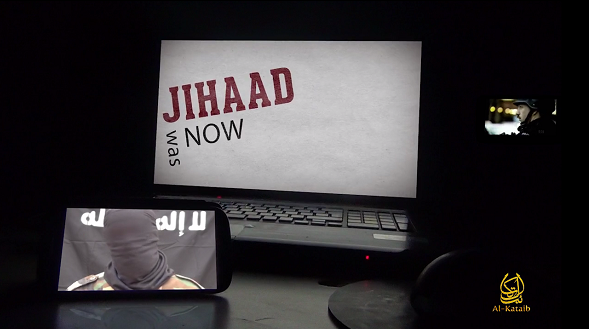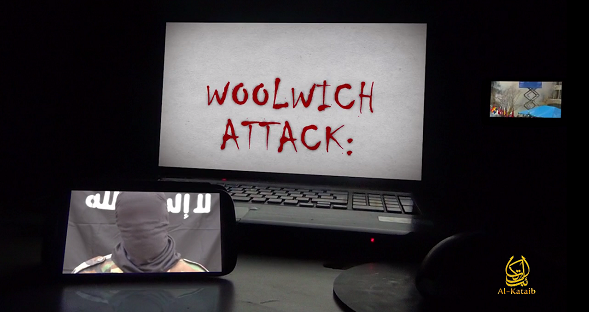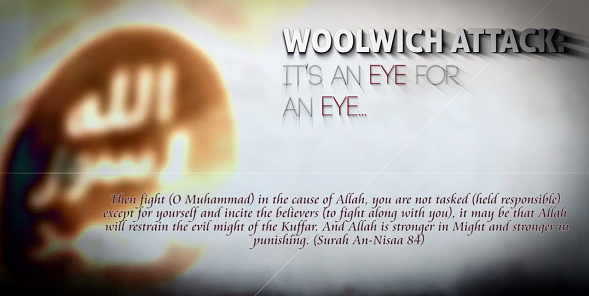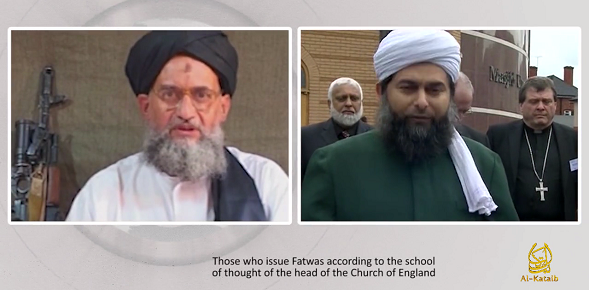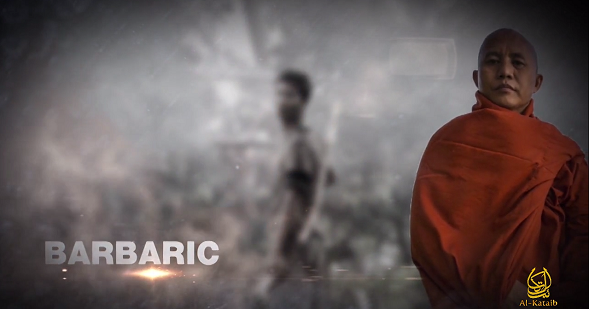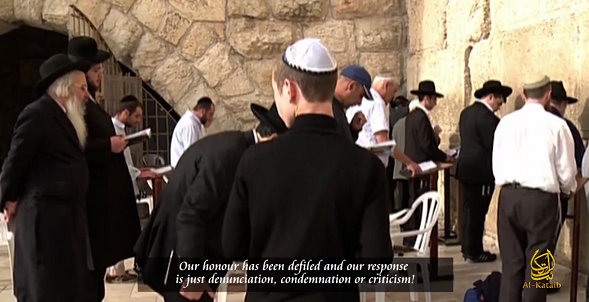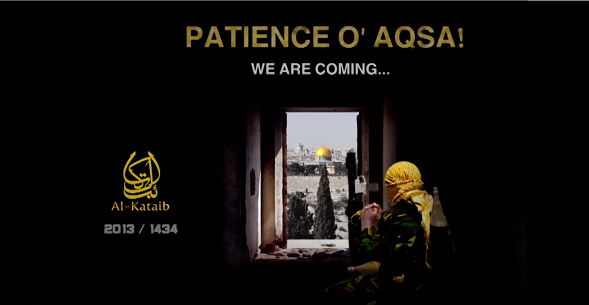Monk Wirathu’s 969 quotes the Dalai Lama’s Kalachakra
Sunday, October 27th, 2013[ by Charles Cameron — a Buddhist instance of the widespread use of sacred texts as offering sanction for religious violence, with Muslims depicted as the enemy on this occasion ]
.
I have commented a couple of times on texts from the Kalachakra Tantra literature about a future war between Buddhism and Islam, first in In a time of Religious Arousal and later more fully in Apocalypse Not Yet? — and today I ran across a reference to the same texts on the web page of the 969 movement in Myanmar.
969 is the monk-led Buddhist movement which has been rioting recently against the Rohingya Muslims, and the monks concerned are Therevadins. The Kalachakra Tantra is the empowerment HH the Dalai Lama gives in the cause of peace, and the tantras are Vajrayana teachings. I think this para from the current Wikipedia article on Buddhism gives the relevant distinctions in a non-contentious form:
Two major branches of Buddhism are generally recognized: Theravada (“The School of the Elders”) and Mahayana (“The Great Vehicle”). Theravada has a widespread following in Sri Lanka and Southeast Asia (Cambodia, Laos, Thailand, Myanmar etc.). Mahayana is found throughout East Asia (China, Korea, Japan, Vietnam, Singapore, Taiwan etc.) and includes the traditions of Pure Land, Zen, Nichiren Buddhism, Tibetan Buddhism, Shingon, and Tiantai (Tendai). In some classifications, Vajrayana — practiced mainly in Tibet and Mongolia, and adjacent parts of China and Russia — is recognized as a third branch, while others classify it as a part of Mahayana.
I won’t go into the theological, philosophical and ritual differences, which are considerable, complex — and somewhat contested.
**
To refresh your memory of the relevant details regarding the Kalachakra’s treatment of “holy war”, here are my key paragraphs on the topic from Apocalypse Not Yet?:
Alexander Berzin has been tutored by HH the Dalai Lama and HHDLs own tutors on the interpretation of the Kalachakra Tantra, and served for some years as HHDL’s translator when HHDL was giving the Kalachakra initiation: indeed his book on the Kalachakra initiation carries a Foreword by HHDL. His writings are thus among the most scholarly and trustworthy available in the western world on the topic of the initiation which the Dalai Lama will impart for world peace again this July.
Berzin’s words introducing the topic of Holy Wars in relation to the Kalachakra, Buddhism and Islam, are therefore important:
Often, when people think of the Muslim concept of jihad or holy war, they associate with it the negative connotation of a self-righteous campaign of vengeful destruction in the name of God to convert others by force. They may acknowledge that Christianity had an equivalent with the Crusades, but do not usually view Buddhism as having anything similar. After all, they say, Buddhism is a religion of peace and does not have the technical term holy war.
A careful examination of the Buddhist texts, however, particularly The Kalachakra Tantra literature, reveals both external and internal levels of battle that could easily be called “holy wars.” An unbiased study of Islam reveals the same. In both religions, leaders may exploit the external dimensions of holy war for political, economic, or personal gain, by using it to rouse their troops to battle. Historical examples regarding Islam are well known; but one must not be rosy-eyed about Buddhism and think that it has been immune to this phenomenon. Nevertheless, in both religions, the main emphasis is on the internal spiritual battle against one’s own ignorance and destructive ways.
Specifically, he writes:
In The Abridged Kalachakra Tantra, Manjushri Yashas explains that the fight with the non-Indic people of Mecca is not an actual war, since the real battle is within the body. The fifteenth-century CE Gelug commentator Kaydrubjey elaborates that Manjushri Yashas’s words do not suggest an actual campaign to kill the followers of the non-Indic religion. The First Kalki’s intention in describing the details of the war was to provide a metaphor for the inner battle…
**
That, then, is the context — “the fight with the non-Indic people of Mecca is not an actual war” but a metaphorical one. Here, by contrast, is the interpretation given to the same text by the 969 movement in an article titled Kalachakra Tantra and 969, posted on their website two months ago (Sept 1st, 2013):
The Kalachakra is a Tibetan Buddhist doctrine on the cycles of time. In addition to being a text, meditation practice, and initiation ritual, Kalachakra is a prophecy for the victory of the Buddhist religion in a war with Islam.
Beginning in 712AD and continuing through 1030AD, India was subject to massive annual invasions from Muslims who eventually conquered and destroyed much of the cultural heritage of India. In a final desperate act to annihilate Buddhism, in 1193, Nalanda University which was home to the greatest center of learnings in the East was destroyed, with thousands of monks beheaded. The destruction of the temples, monasteries, centres of learning at Nalanda and northern India to be responsible for the demise of ancient Indian scientific thought in mathematics, astronomy, alchemy, and anatomy. Much of what modern scholarship of Buddhist studies puzzles over today was contained in the manuscripts and minds of those who were lost during this calamity. However as the Kalachakra Tantra shows, the war between Dhamma and Islam is not over, nor is it. The prophecy includes detailed descriptions of the future invaders as well as suggested ways for the Buddhist teachings to survive these onslaughts.
The Dalai Lama has stated that the public exposition of this tantra is necessary in the current degenerate age. The initiation may be received simply as a blessing for the majority of those attending, however, many of the more qualified attendees do take the commitments and subsequently engage in the practice.
In a phrase, “Kalachakra is a prophecy for the victory of the Buddhist religion in a war with Islam”.
That’s the opening of the article, clearly identifying the Kalachakra as a text about Buddhism vs Islam. There follows a curious incomplete sentence:
We must be diligent in reminding the
I’d love to know what the author wanted to remind us of, and what the rest of that paragraph — or group of paras? — had to say about the Kalachakra, but the rest of the text as printed is no longer talking about warfare, but explaining some basic notions in Buddhism:
It is important to notice what Alexander Berzin wrote how “Karmic potentials, in fact, give rise to a broad array of impulses that affect our lives. Collective karmic potentials from previous actions of a huge number of beings – including ourselves – give rise, for example, to the impulse for a universe to evolve with specific environments and life forms into which we and these beings subsequently take rebirth.” Collective karma can be seen as the actions that have generated us in our present bodies, from the decisions of our parents, ancestors, and peers that gives us the appearance of our lives (Janaka kamma or the kamma that determines birth). We are all recipients of karma beyond our control. Put in another way, our DNA contains a vast storehouse of kamma.
This sad state of affairs is where the Kalachakra initiation takes its cue. By harnessing ritual and intention, the Kalachakra initiation at its highest level bestows a daily practice for awakening that an army of practioners around the world are also engaging in. This collective kamma has the subtle effect of making the conditions of purifying bad kamma’s and unwholesome dhamma’s into virtuous ones.
Ultimately we feel this will have the eventual effect of producing a Dhamma centered world based on the natural laws of mind that the founders of the 969 Movement are striving to achieve.
Whether or not warfare, as suggested in the first section of the article, is compatible with Buddhism, as expressed in the second, is a matter for Buddhist theological debate — as is the nature of “war” as envisioned in the Kalachakra itself.
My own purpose in making this post is to point out that the 969 movement, led by Buddhist monks in Myanmar, is now quoting a prophecy of war against Islam, found in the Kalachakra literature, which in turn is taught as a instrument of peace by HH the Dalai Lama. To my ears, that sets up a howl of cognitive dissonance.




